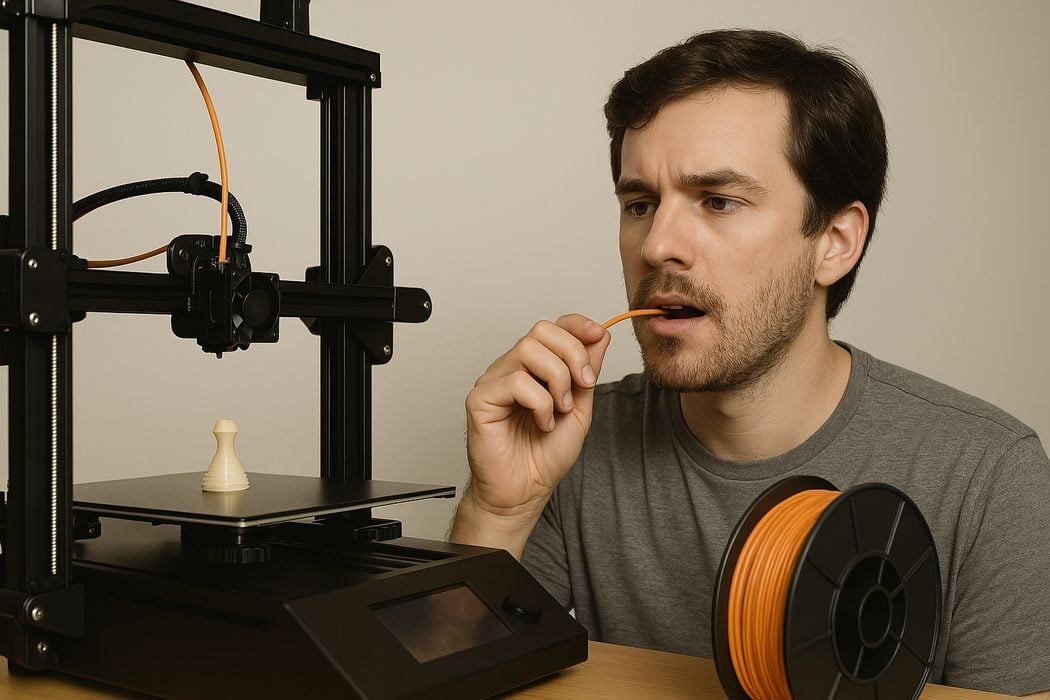
FilaMunch announced a new line of 3D printer filament — with a surprising feature.
For years, 3D printing has flirted with the culinary world. We’ve seen printers that extrude chocolate, printers that build sugar structures, and even experiments involving paste-like cheeses and peanut butter. But these setups typically rely on food as filament — not filament as food.
That may now be changing.
A new California startup named FilaMunch Materials has announced what they claim is the world’s first edible filament — a true thermoplastic-like material that not only meets food contact safety standards, but is designed to be eaten.
The product, branded as PLAte, is a proprietary blend of plant starches, natural binders, and food-safe stabilizers. It prints similarly to PLA, with extrusion temperatures between 170–180°C, and requires no heated bed. But unlike traditional PLA, it comes in flavors.
“We wanted to eliminate the line between food-safe and food-itself,” said FilaMunch founder and CTO, Dr. Serena Krumbel. “If you’ve ever hovered hungrily over your printer during a 14-hour print job, wondering what the filament might taste like, well — now you don’t have to wonder.”
According to the company, PLAte is available in five initial flavors:
- Printzel (salty pretzel)
- Fettucina (lightly garlic-infused pasta)
- Berry Benchy (mixed berry)
- Grilled Cheese Yellow
And a limited edition ABSinthe Mint (alcohol-free, but curiously spicy)
Importantly, FilaMunch emphasizes that prints made from PLAte are safe to eat, though the company recommends consuming them within 48 hours of printing “for best chewiness.” While the material is shelf-stable in filament form, once printed, it begins to reabsorb ambient moisture — a characteristic that gives it a soft, breadstick-like texture over time.
The printability is said to be comparable to low-speed PLA, though the company recommends a dedicated nozzle, as “the flavor notes can linger.”
To maintain hygiene, FilaMunch ships PLAte in vacuum-sealed spools, with a light desiccant pack and a nutrition label. Yes — you can count calories per gram of extrusion. One standard Benchy contains roughly 43 calories, though the “Grilled Cheese Yellow” variant is closer to 70.
Asked about the potential use cases, Dr. Krumbel listed a surprising range:
- Themed dinnerware that can be consumed after the meal
- Custom-shaped party snacks (miniature edible trophies, logos, or cake toppers)
- Emergency rations for hikers with portable 3D printers
- And of course, mid-print snacking, a feature long requested by the community
Early testers have praised the material’s novelty and surprising taste. One beta user wrote, “I printed a spoon, used it to stir soup, and then ate the spoon. My wife was briefly impressed.”
Critics, however, have raised questions about cross-contamination, particularly for makers using machines that previously handled non-food-safe plastics. FilaMunch recommends using a clean, dedicated machine for food-printing, or investing in a hotend sterilizer — which they also sell, naturally.
As of today, PLAte is available for preorder, with spools priced at US$34.95 for 500g. The company says it is working on vegan and gluten-free variants, and may even explore savory/spicy dual-extrusion international options in the near future.
Whether it becomes a staple of the desktop kitchen or just a passing fad remains to be seen — but one thing is clear: this filament is good enough to eat.
Via FilaMunch
